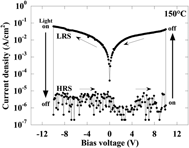Article contents
Photomemristors using carbon nanowall/diamond heterojunctions
Published online by Cambridge University Press: 06 February 2019
Abstract

This work demonstrates the in situ growth of carbon nanowalls (CNWs) on diamond semiconductors by microwave plasma-assisted chemical vapor deposition. The resulting CNW/diamond junctions behave as photomemristors having both photocontrollable multiple resistance states and nonvolatile memory functions. The resistance state (high or low resistance) can be selected by irradiation with blue or violet light in conjunction with the application of a bias voltage, giving a large resistance switching ratio of ∼106. The photoinduced resistance switching behaviors are rarely observed and has only been observed in a few materials and/or heterostructures. These junctions also exhibit a photoresponsivity of ∼12 A/W, which is much larger than that obtained from photodiodes composed of other materials. These results suggest that CNW/diamond (i.e., carbon sp2/sp3) junctions could have applications in novel photocontrollable devices, which have photosensing, memory, and switching functions.
- Type
- Article
- Information
- Copyright
- Copyright © Materials Research Society 2019
References
- 5
- Cited by




